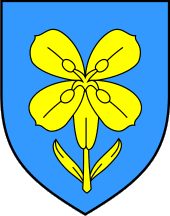Donji Lapac
| Donji Lapac Доњи Лапац (Serbian)[1] | ||
|---|---|---|
| Municipality | ||
| Donji Lapac Municipality Općina Donji Lapac | ||
|
Orthodox church of Pentecost in Donji Lapac | ||
| ||
 Donji Lapac Location of Donji Lapac in Croatia | ||
| Coordinates: 44°33′N 15°58′E / 44.550°N 15.967°ECoordinates: 44°33′N 15°58′E / 44.550°N 15.967°E | ||
| Country |
| |
| County | Lika-Senj | |
| Government | ||
| • Mayor | Dušan Šijan (SDP) | |
| Area | ||
| • Total | 353 km2 (136 sq mi) | |
| Population (2011)[2] | ||
| • Total | 2,113 | |
| Time zone | CET (UTC+1) | |
| • Summer (DST) | CEST (UTC+2) | |
| Website |
www | |
Donji Lapac (Serbian Cyrillic: Доњи Лапац) is a village and a municipality in Lika, Croatia.
Geography
Donji Lapac is located a region of eastern Lika called Ličko Pounje, by the river Una that flows near the town in the valley between mountain Plješevica and Una on the altitude of 582 m. It is connected with the road that connects Bihać with Gračac.
History
The area of Donji Lapac has been inhabited since the Iron age, which many material remains prove. During medieval times the area of Lapac was part of old-Croatian Lapac župa and in 1449 it became possession of Frankopans. Old city Lapac was located on a nearby Obljaj hill (666 m) south from Donji Lapac. When in 1528 Ottomans conquered Lika, Lapac was absorbed.
Donji Lapac was founded in 1791, in the year the Austro-Ottoman war ended and Eastern Lika was annexed by Habsburg empire as a frontier post. In the late 19th century and early 20th century, Donji Lapac was a district capital in the Lika-Krbava County of the Kingdom of Croatia-Slavonia. In 1941 Yugoslav partisans liberated the district center.
During the Croatian War of Independence, Donji Lapac was incorporated along with other towns into the unrecognized breakaway Republic of Serbian Krajina. In August 1995, it was returned to Croatian control following victories by the Croatian army. According to the International Criminal Tribunal for the former Yugoslavia, the Croatian conquest of the municipality was accompanied by widespread looting and ethnic cleansing by the Croatian forces, including the murder of four elderly civilians in the municipality of Donji Lapac, crimes which formed part of the indictment and conviction of the Croatian general Ante Gotovina and Mladen Markač.[3]
Demographics
According to the 2011 census, the town has population of 946 and a municipality of 2,113 people.[2] Before the war the area was almost entirely Serb-populated with only 0.5% Croats (according to the 1991 census). After the war the area of Donji Lapac municipality grew smaller because villages of Donji Srb and Gornji Srb were given to Municipality of Gračac in Zadar County. However, according to the 2011 census Serbs continue to constitute a majority of 80.6%, with 18.8% of Croat population.[4]
| Year of census | total | Serbs | Croats |
|---|---|---|---|
| 1910 | 17,433 | 15,995 (91.75%) | 1,435 (8.23%) |
| 1961 | 6,456 | 6,148 (95.23%) | 202 (3.13%) |
| 1971 | 9,609 | 9,337 (97.17%) | 94 (0.97%) |
| 1981 | 8,337 | 7,691 (91.05%) | 47 (0.56%) |
| 1991 | 8,054 | 7,854 (97.51%) | 44 (0.54%) |
| 2001 | 1,880 | 1,383 (73.56%) | 471 (25.05%) |
| 2011 | 2,113 | 1,704 (80.64%) | 397 (18.79%) |
Some Croats or Serbs declared their ethnicity as Yugoslav.
Economy
Today Donji Lapac is one of the poorest municipalities in Croatia and is included in area of special state care. Before the war, Donji Lapac had a developed wood and textile industry. Many people worked in the transportation company Likatrans which employed more than 200 people. Today most of the inhabitants are unemployed and jobs are mostly restricted to public services or the renewed wood industry. Additionally many people work in basic agriculture, growing mostly potatoes and plums from which they make the alcohol Slivovitz.
Towns and Villages in Municipality
|
|
Notable people
- Milan Đukić, Croatian Serb politician
- Veljko Narančić, Yugoslav athlete
- Stevo Krnjajić, Yugoslav actor
References
- ↑ Government of Croatia (October 2013). "Peto izvješće Republike Hrvatske o primjeni Europske povelje o regionalnim ili manjinskim jezicima" (PDF) (in Croatian). Council of Europe. p. 36. Retrieved 30 November 2016.
- 1 2 "Population by Age and Sex, by Settlements, 2011 Census: Donji Lapac". Census of Population, Households and Dwellings 2011. Zagreb: Croatian Bureau of Statistics. December 2012.
- ↑ Judgment of the International Tribunal for the Prosecution of Persons Responsible for Serious Violations of International Humanitarian Law Committed in the Territory of the Former Yugoslavia since 1991, 15 April 2011, retrieved 15 April 2011
- ↑ "Population by Ethnicity, by Towns/Municipalities, 2011 Census: County of Lika-Senj". Census of Population, Households and Dwellings 2011. Zagreb: Croatian Bureau of Statistics. December 2012.
External links
- Official site (Croatian)

